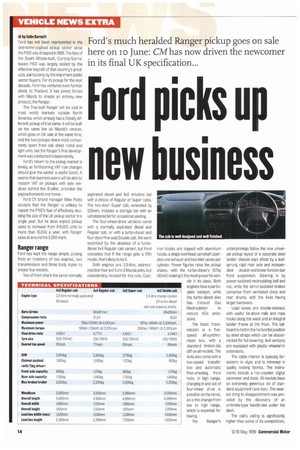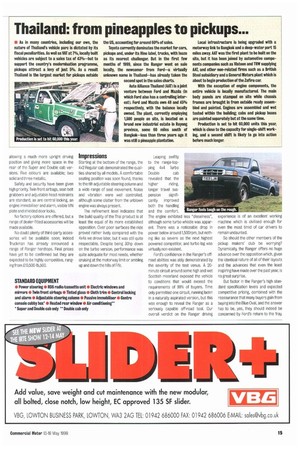Ford picks up new business
Page 16

Page 17

If you've noticed an error in this article please click here to report it so we can fix it.
Ford's much heralded Ranger pickup goes on sale here on To June: CM has now driven the newcomer in its final UK specification...
• by Coin Barnett
Ford has not been represented in the one-tonne-payload pickup sector since the P100 was dropped in 1989. The fate of the South African-built, Cortina/Sierrabased P100 was largely sealed by the effective boycott of that country's products, particularly by the important public sector buyers. For its pickup for the next decade, Ford has ventured even further afield, to Thailand. it has joined forces with Mazda to create an entirely nev product, the Ranger.
The Thai-built Ranger will be sold in most world markets outside North America, which already has a (totally different) pickup of that name. It will be built on the same line as Mazda's version, which goes on UK sale at the same time, and the two pickups share most components apart from cab sheet metal and light units, but the Ranger's final development was conducted independently.
Ford's return to the pickup market is timely, as forthcoming VAT rule changes should give the sector a useful boost. It seems that business users will be able to reclaim VAT on pickups with side windows behind the B-pillar, provided the payload exceeds one tonne.
Ford CV brand manager Mike Platts accepts that the Ranger is unlikely to repeat the P100's feat of effectively doubling the size of the UK pickup sector in a single year. But he does expect pickup sales to increase from 8-9,000 units to more than 10,000 a year, with Ranger sales at around the 3,000 mark.
Ranger range Ford has kept the range simple, picking from an inventory of two engines, two transmissions and three body styles to create four models.
Two of them share the same normally aspirated diesel and 4x2 driveline but with a choice of Regular or Super cabs. The two-door Super cab, extended by 525mm, includes a storage bin with an upholstered lid for occasional seating.
The four-wheel-drive versions come with a normally aspirated diesel and Regular cab, or with a turbo-diesel and four-door/five-seat Double cab. We were surprised by the absence of a turbodiesel 4x4 Regular cab variant, but Ford concedes that if the range gets a fifth model, that's likely to be it.
Both engines are 2.5-litre, indirectinjection four-pot Euro-2 Mazda units, but considerably revised for this role. Cast iron blocks are topped with aluminium heads; a single overhead camshaft operates one exhaust and two inlet valves per cylinder. Power figures raise the pickup stakes, with the turbo-diesel's 107hp (80kW) making it the most powerful vehicle in its class. Both engines have a particulate catalyst, while the turbo-diesel also has Exhaust Gas Recirculation to reduce Kix emissions.
The basic transmission is a five speed all-synchromesh box, with a standard limited-slip diff on all models. The 4x4s also come with a two-speed transfer box and automatic free-wheeling front hubs. In high range, changing in and out of four-wheel drive is possible on the move, as is the change from low to high range, which is essential for towing.
The Ranger's underpinnings follow the now universal pickup layout of a separate steel ladder chassis kept afloat by a leafsprung rigid rear axle and independent double-wishbone/torsion-bar front suspension. Steering is by power-assisted recirculating ball and nut, while the servo-assisted brakes comprise front ventilated discs and rear drums, with the 4x4s having larger hardware.
Load boxes are double-skinned, with useful tie-down rails and rope hooks along the waist and an integral ladder frame at the front. The tailboard is held in the horizontal position by steel straps which can be disconnected for full lowering: 4x4 versions are equipped with plastic vvheelarch extensions.
The cabin interior is typically fareastern in style and is trimmed in quality looking fabrics. The instruments include a rev-counter, digital odometer and clock. All models have an extremely generous list of standard equipment (see box). The nearest thing to disappointment was provided by the discovery of an umbrella-type handbrake under the dash.
The cab's ceiling is significantly higher than some of its competitors, Mowing a much more upright driving position and giving more space in the rear of the Super and Double cab versions. Five colours are available; two solid and three metallic.
Safety and security have been given high priority. Twin front airbags, seat-belt grabbers and adjustable head restraints are standard, as are central locking, an engine immobiliser and alarm, visible VIN plate and shielded door locks.
No factory options are offered, but a range of dealer-fitted accessories will be made available.
No doubt plenty of third-party accessories will be available soon; indeed Truckman has already announced a range of Ranger hardtops. Final prices have yet to be confirmed but they are expected to be highly competitive, ranging from 110,500-15,500.
Impressions
Starting at the bottom of the range, the 4x2 Regular cab demonstrated the qualities shared by all models. A comfortable seating position was soon found, thanks to the tilt-adjustable steering column and a wide range of seat movement. Noise and vibration were well controlled, although some clatter from the unblown engine was always present.
The refinement level indicates that the build quality of the Thai product is at least the equal of its more established opposition. Over poor surfaces the ride proved rather lively compared with the 4x4s we drove later, but it was still quite respectable. Despite being 30hp down on the turbo version, performance was quite adequate for most needs, whether cruising at the motorway limit or ambling up and down the hills of Fife. Leaping swiftly to the range-topping 4x4 Turbo Double cab revealed that the higher riding, longer travel sus
pension significantly improved both the handling and the comfort The engine exhibited less "dieselness", although some turbo whistle was apparent There was a noticeable drop in power below around 1,500rpm, but nothing like as severe as the next highest powered competitor, and turbo lag was virtually non-existent.
Ford's confidence in the Ranger's offroad abilities was ably demonstrated by the severity of the test venue. A 20minute circuit around some high and wet Scottish moorland exposed the vehicle to conditions that would exceed the requirements of 99% of buyers. Time only permitted one circuit, running laden in a naturally aspirated version, but this was enough to reveal the Ranger as a seriously capable off-road tool. Our overall verdict on the Ranger driving
experience is of an excellent working machine which is civilised enough for even the most timid of car drivers to remain undaunted.
So should the other members of the pickup makers' club be worrying? Dynamically, the Ranger offers no huge advance over the opposition which, given the identical nature of all of their layouts and the advances that even the least inspiring have made over the past year, is no great surprise.
But factor in the Ranger's high standard specification levels and expected competitive pricing, combined with the reassurance that many buyers gain from buying into the Blue Oval, and the answer has to be, yes, they should indeed be concerned by Ford's return to the fray.
STANDARD EQUIPMENT
Power steering • RDS radio/cassette unit • Electric windows and mirrors • Twin front airbags S Tinted glass • Cloth trims Central locking and alarm • Adjustable steering column • Passive immobiliser • Centre console cubby box .• Heated rear window • Air conditioning" ' Super and Double cab only "Double cab only
















































































































